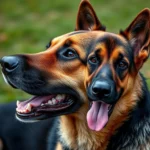
Introduction
Dogs have been our loyal companions for thousands of years, serving various roles in our lives. Understanding different dog breeds is crucial for potential owners, as each breed comes with its own unique traits, needs, and behaviors. This knowledge empowers individuals to make informed decisions when selecting a pet that fits their lifestyle and family dynamics. Among the myriad of dog breeds, the boingle stands out as a fascinating mix that deserves special attention. In this article, we’ll delve into the significance of dog breeds, provide an overview of popular breeds, and take an in-depth look at the boingle breed, including its characteristics, care, and health considerations.
Understanding Dog Breeds
Definition of Dog Breeds
A dog breed is a specific group of domestic dogs with distinct characteristics and traits that set them apart from others. These traits can include size, coat type, temperament, and behavioral tendencies. The concept of dog breeds has evolved over centuries, with historical breeding practices designed to enhance specific qualities, such as hunting ability, herding instincts, or companionship.
The Purpose of Dog Breeds
Dog breeds can generally be categorized into two main types: working dogs and companion dogs. Working dogs are bred for specific tasks like herding, guarding, or performing search-and-rescue missions. Companion dogs, on the other hand, are primarily bred for emotional support and companionship. Each breed has a unique role in society, whether it’s the steadfast loyalty of a Labrador Retriever or the keen instincts of a Bloodhound.
The Science of Breeding
At the heart of dog breeding lies genetics. Selective breeding allows breeders to emphasize desired traits while minimizing undesirable ones. This meticulous process can influence a dog’s size, coat, temperament, and even health predispositions. Understanding the science behind dog breeds can help prospective owners appreciate the complexities involved in breeding and the responsibilities that come with dog ownership.
Overview of Popular Dog Breeds
Grouping of Dog Breeds
The American Kennel Club (AKC) classifies dog breeds into several groups based on their characteristics and roles. Here’s a brief overview of these groups:
- Sporting Group: Dogs bred for hunting and retrieving.
- Hound Group: Dogs known for their keen sense of smell and tracking abilities.
- Working Group: Breeds developed for specific tasks like guarding and pulling sleds.
- Terrier Group: Energetic breeds originally bred for hunting vermin.
- Toy Group: Small dogs, often bred for companionship.
- Non-Sporting Group: Diverse breeds that don’t fit into other categories.
- Herding Group: Intelligent breeds that assist in herding livestock.
- Miscellaneous: Breeds awaiting full recognition.
Detailed Profiles of Select Breeds
Sporting Group
Breeds in the sporting group are known for their energetic and friendly nature. Notable breeds include:
- Labrador Retriever: Friendly, intelligent, and versatile; ideal for families.
- Golden Retriever: Affectionate and eager to please; great for active households.
- Cocker Spaniel: Playful and gentle; suitable for families with children.
Hound Group
The hound group includes breeds with strong tracking instincts:
- Beagle: Friendly and curious; requires regular exercise.
- Greyhound: Known for speed; enjoys lounging at home.
- Bloodhound: Exceptional sense of smell; needs ample mental stimulation.
Working Group
These breeds are known for their strength and intelligence:
- Boxer: Playful and loyal; needs plenty of exercise.
- Rottweiler: Confident and protective; requires firm training and socialization.
- Siberian Husky: Energetic and friendly; thrives in active environments.
Terrier Group
Terriers are spirited and lively:
- Jack Russell Terrier: Highly energetic; requires a lot of stimulation.
- Bull Terrier: Playful and affectionate; good with kids.
- Scottish Terrier: Independent and dignified; enjoys family time.
Toy Group
Perfect for apartment living, these small breeds are charming companions:
- Chihuahua: Alert and lively; forms strong bonds with owners.
- Pomeranian: Playful and outgoing; requires regular grooming.
- Yorkshire Terrier: Affectionate and bold; enjoys being pampered.
Non-Sporting Group
Diverse breeds that don’t fit into other categories:
- Bulldog: Gentle and affectionate; low exercise needs.
- Dalmatian: Active and protective; needs regular exercise.
- Poodle: Intelligent and versatile; available in standard, miniature, and toy sizes.
Herding Group
Known for their intelligence and trainability:
- Australian Shepherd: Energetic and intelligent; excels in training.
- Border Collie: Highly trainable and active; needs mental challenges.
- German Shepherd: Loyal and protective; often used in service roles.
The “Boingle” Breed
Introduction to the Boingle
The boingle is an intriguing hybrid breed that combines the characteristics of the Beagle and the Basset Hound. This unique mix results in a dog that is both playful and affectionate, making it an excellent family companion. The boingle has gained popularity due to its charming demeanor and adaptability to various living situations.
Physical Characteristics
The boingle is a medium-sized dog with a distinctive appearance. It typically features:
- Size: Ranges from 30 to 50 pounds.
- Coat Type: Short and dense, requiring minimal grooming.
- Color Variations: Commonly found in combinations of tan, black, and white.
The boingle often inherits the long ears and droopy eyes of the Basset Hound, combined with the more compact body of the Beagle, creating a unique and endearing look.
Temperament and Behavior
The boingle is known for its friendly and sociable nature. Here are some key traits:
- Personality: Playful, affectionate, and eager to please, making it great for families.
- Socialization Needs: Requires early socialization to ensure it grows up to be a well-rounded dog.
Boingles generally get along well with children and other pets, making them an excellent choice for households with multiple family members.
Care and Maintenance
Caring for a boingle involves several essential aspects:
- Grooming Requirements: Their short coat requires minimal grooming, but regular brushing helps reduce shedding.
- Exercise Needs: The boingle is an active breed that enjoys daily walks and playtime, making it essential to provide regular physical activity to keep them healthy and happy.
Health Considerations
Like all breeds, the boingle can be prone to certain health issues, including:
- Ear Infections: Due to their floppy ears, regular ear cleaning is necessary.
- Obesity: They can easily gain weight if not exercised adequately, so monitoring their diet is crucial.
Regular veterinary check-ups and a balanced diet can help mitigate these health risks and keep your boingle thriving.
Choosing the Right Dog Breed
Factors to Consider
When selecting a dog breed, consider your lifestyle:
- Active vs. Sedentary: Choose a breed that aligns with your activity level. Energetic breeds like the boingle need regular exercise, while more laid-back breeds may be a better fit for a sedentary lifestyle.
- Space Requirements: Larger breeds may need more space to roam, while smaller breeds can adapt to apartment living.
Age and Activity Level of Family Members
The ages and activity levels of family members can significantly influence your choice:
- Children: Breeds known for their gentle temperament, like the boingle, are suitable for families with young kids.
- Seniors: Smaller, calmer breeds may be more appropriate for older individuals or those with mobility issues.
Researching Breeds
Gathering information about different breeds can help you make an informed decision. Utilize resources such as:
- Breed-Specific Rescues: Many organizations offer detailed information about specific breeds and can guide you in finding a suitable match.
- Online Communities: Engage with other dog owners to get firsthand experiences and insights.
Conclusion
Choosing the right dog breed is a significant decision that impacts both your life and the dog’s life. Understanding the diverse world of dog breeds, including the charming boingle, can help you find the perfect companion that fits your lifestyle and family dynamics. As you embark on this journey, remember to research all factors, ensuring a happy and healthy relationship with your four-legged friend.
In this comprehensive guide, we’ve explored the significance of dog breeds, provided detailed profiles of popular breeds, and focused on the unique qualities of the boingle breed. By understanding these various aspects, you can make an informed and thoughtful decision when welcoming a new dog into your home.









